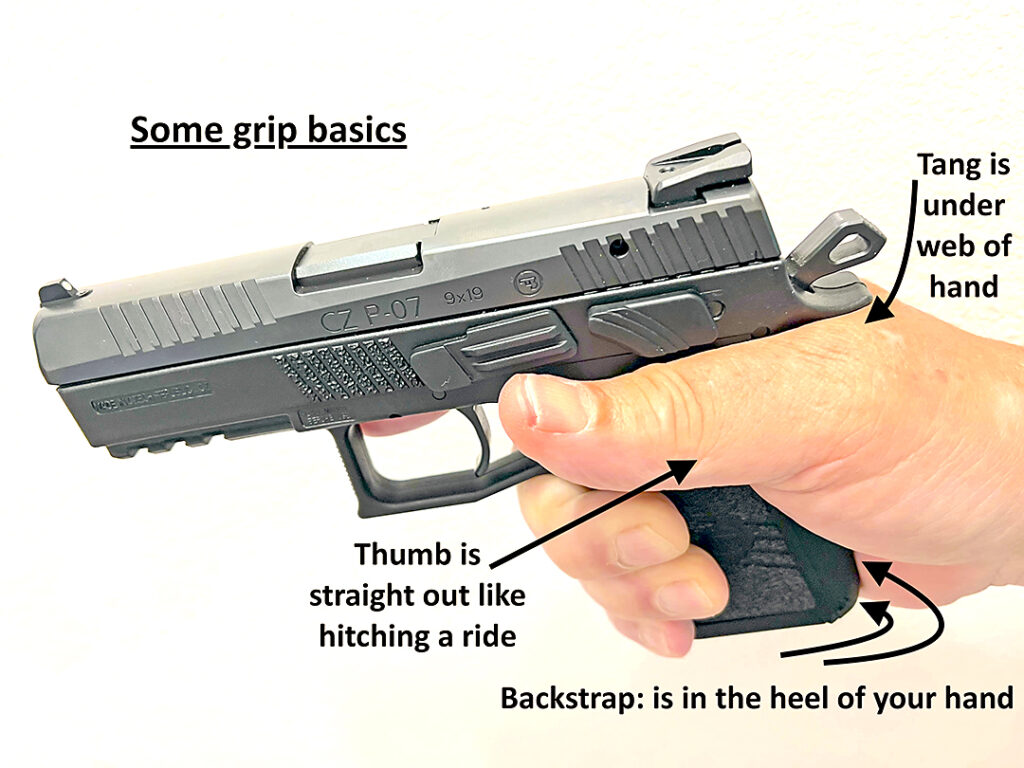Thoughts on a good grip, Part 1


I’ve been reading several articles on how to grip your handgun. One in particular is by Richard Nance on the site Guns & Ammo. While it is full of good information, it seems to have been written for people who have been shooting for a long time and who want to polish up their already good skills.
I’m saying this because Richard uses big words, and also terms that he assumes we understand already.
While I appreciate his knowledge, I’m wondering how the new shooter can understand this article. Even though I myself have been shooting for many years, there are places where I’m reading the article aloud to Joe and asking: “What exactly, does he mean by this? And what does this word mean? Why is he saying this? Let’s ask Newbie what she gets from this article!”
So, since Nance’s information is well worth considering, I’m going to re-present his article so that Newbie can begin his/her shooting experience by using his thoughts.
“Our hands are the interface between you and your pistol. The grip you establish and maintain largely determines how fast and accurately you can shoot. When firing a single shot, just about any grip will do, but when the goal is to hit the target multiple times in rapid succession, grip becomes critical.”
Why “multiple times”?
Newbie says: “I just want to hit the target!”
Nance has other ideas. He knows that hitting Mr. Bad is not sufficient to neutralize the threat. Mr. Bad might keep coming at us, even if he has been hit once, or Mr. Bad may have evil friends with him; also wanting to do great harm to us. This is why Nance is cautioning us to learn how to hit that target “multiple times in rapid succession.”
Newbie thinks: “Oh. Right. One shot might not save me.”
Now Nance proceeds to tell us how to grip the gun for accuracy and rapid following shots.
First, he says to “grip as high along the backstrap as possible” and “the closer you grip to the bore line, the better your body will absorb recoil…” He goes on to say “There can be no gap between the web of your hand and the tang of the pistol.”
My Newbie friend says: “What’s a backstrap? What’s a bore line? Where’s the tang?”
Let’s talk backstrap and tang.
In plain English, the backstrap is the back of the grip closest to you. It has a curve at the top. This curve is the tang. So, you grip high on the backstrap until your thweb (the web between thumb and forefinger) is gripping the tang. Your thweb must be securely all the way up into the tang. If you don’t seat your grip firmly here, you’ll lose control of the gun causing muzzle flip.
The muzzle of the gun is the front part of the gun containing the barrel and the front sight. You want this part to stay steady on your target. If it flips, you won’t be hitting the target very well.
Nance also says to keep the bore line close to your body to help reduce recoil. Newbie says: “I know recoil is kick, but where is the bore line?”
The bore line is an imaginary line from the muzzle of the gun going through the barrel to your grip. If your hand is securely in the tang, it will be close to this bore line. So, placing the web of your hand firmly into the tang will contribute to holding the gun steady and reducing recoil.
Newbie says and demonstrates while pointing her unloaded gun in a safe direction: “Okay, now I get it. Here’s my hand high in the top of the backstrap. This is the tang. My hand is as close to the bore line as it can get!”
Now Nance suggests flagging your thumb as if you “were trying to hitch a ride.”
Newbie grins. “I can do that!” and she places her thumb forward on the frame of the gun.
Then, for optimal recoil control, Nance says to align the gun with your forearm. The reason for this is it aligns the gun with your large bones and muscles, giving your gun good support. Your gun needs to stay steady and not move when you shoot.
When shooting, the top part of the gun, the slide, will move forward with the shot and then will come rapidly back toward you. With proper alignment of the gun and your forearm, the slide will cycle smoothly forward and back. If there is no alignment of gun and forearm, the slide and frame will wobble together as the slide returns, so the slide can’t cycle fully and both slide and frame wobble.
You’ve heard the term “limp-wristing?” Without aligning the gun to your forearm, that resulting wobble is “limp-wristing.” This wobble could also result in a failure of the gun to feed the next round or a failure to eject the casing.
Newbie says: “A guy at the range said I was limp-wristing my gun. He didn’t sound very nice. I guess I wasn’t holding the gun and aligning it firmly. I know my arm jerked backwards with the recoil.”
Nance warns us of a gun that has a grip too wide for the shooter and of a shooter who doesn’t have the strength to pull the trigger. What the shooter does to compensate is to rotate his hand counterclockwise to reach further into the trigger.
Newbie: “So, if it works to reach the trigger, why knock it?”
Because, Nance clarifies, turning your hand like this aligns the gun to the base of your thumb. This area is weaker than your forearm. Since the base of your thumb is weaker, you won’t be as able to manage the recoil. Again, not managing recoil can result in “limp-wristing,” failure to feed the next round, or failure to eject the casing of your round. Nance stresses: “the base of your thumb is a sorry substitute for your forearm from a recoil management stand point.”
Another way to lessen recoil is to lock your wrists. Nance explains how to acquire a proper locking grip.
Newbie wonders: “How do I place both hands? What makes for a good grip?”
We will learn along with Newbie in Thoughts on a Good Grip, Part 2, next week in The Wakulla Sun.
Marj Law is the former director of Keep Wakulla County Beautiful who has become an avid shooter in retirement.


